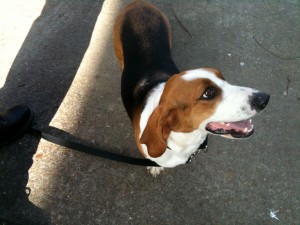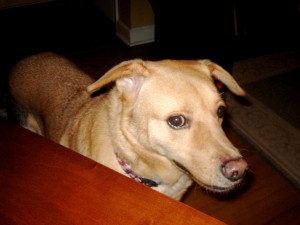 Sometimes I see clients whose dogs were previously house trained, but recently started eliminating inside. The causes can range from medical or dietary issues, attention seeking behaviors, to anxiety and fearful behaviors. You’ll need to determine the root cause before you can fix it.
Sometimes I see clients whose dogs were previously house trained, but recently started eliminating inside. The causes can range from medical or dietary issues, attention seeking behaviors, to anxiety and fearful behaviors. You’ll need to determine the root cause before you can fix it.
Here is the inappropriate inside elimination questionnaire that I use for remote house training consultations. I use this form to determine the root cause.
 Print This Post
Print This Post
______________________________________________________________
Inappropriate Elimination Worksheet– for dogs that were previously house trained and inside elimination represents a change in behavior.
Have medical tests been conducted since the onset of the inappropriate elimination behavior(s) for the specific goal of identifying or ruling out a medical cause(s) for the behavior(s)?
Yes No
How long has the problem behavior been occurring?
__________________________________________________________________________
How often does the behavior occur?
______________________________________________________________________________
Is the number of incidents increasing in frequency? Yes No
Behavior occurs only in the (visible) presence of persons yes no
Behavior occurs only in the absence of persons: yes no
Behavior occurs both in the presence of and in the absence of persons: yes no:
Were there changes in the external environment that coincided with the onset of elimination disorder? (i.e. new/remodeled home, moved furniture, installed fencing (including ‘invisible’ fencing), added room mate, schedule change, added pet, lost pet, lost room mate, etc.)
Yes No
If yes to above question, please explain.
______________________________________________________________________________
______________________________________________________________________________
Was there a change in dietary and elimination environment at or after the onset of the behavior? (type/brand/amounts of food recently changed, water consumption change, location of outside area used for elimination, willingness to go outside, etc.) Yes No
If yes, please explain._______________________________________________________________________
______________________________________________________________________________
Are there any other behavioral changes you have noticed at or after the onset of the problem elimination? (destructive behaviors, barking, mounting, object stealing, tail chasing, shadow stalking, storm phobia, firework or noise phobia, eating non-food items, etc.) Yes No
If yes to the above question, please explain.
______________________________________________________________________________
______________________________________________________________________________
Does the problem behavior occur more often in any particular location(s)? Yes No
List area(s) of most recent problem elimination and flooring type. (i.e. inside crate in den, kitchen on tile floor, back bedroom on carpet, living room curtains on carpet, cabinet in kitchen on tile floor, etc.)
______________________________________________________________________________
______________________________________________________________________________
Please check the type(s) of elimination occurring inside. Urination Defecation
If defecation selected in previous question, circle the consistency of stool.
Hard Soft but firm Firm then partially liquid Diarrhea Variable
Will the dog readily walk outdoors for a walk, or to play?
Yes No
Will the dog readily eliminate outdoors –on or off lead -in the presence of traffic, strangers, other dogs, loud noises, in bad weather, rain, cold, or other distractions?
Yes No Maybe _________________________________________
Where does the dog eliminate outside? List area and ground type. (i.e. back patio on concrete, back yard-anywhere on grass, backyard in designated area on grass, backyard on grass or concrete, during walks on grass, during walks on street, etc.)
______________________________________________________________________________
Does the dog eliminate inside regardless of schedule of outside exercise/outings and may eliminate immediately after you return indoors?
Yes No
Does the quantity of inside-the-home excretions indicate full-fledged elimination? Yes No
Are there numerous small amounts of urine deposited inside? Yes No
Please list any additional information you feel is relevant to the inside elimination problem behavior. Thank you.
______________________________________________________________________________
______________________________________________________________________________
______________________________________________________________________________

